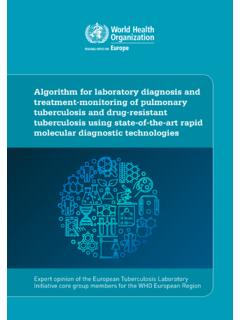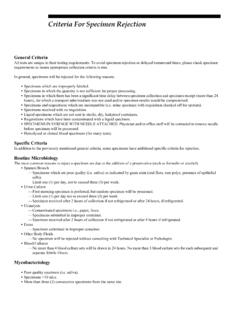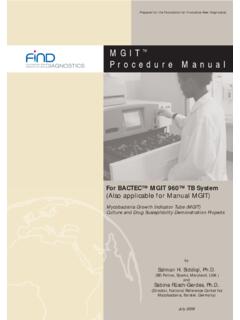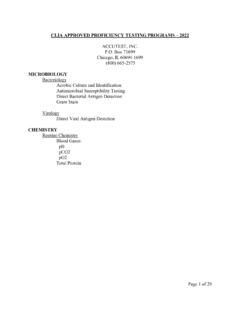Transcription of Tuberculin Skin Testing - Centers for Disease Control and ...
1 CS 320275-ASeptember 2020 Tuberculin skin TestingWhat is it?The Mantoux Tuberculin skin test (TST) is one method of determining whether a person is infected with Mycobacterium tuberculosis. Reliable administration and reading of the TST requires standardization of procedures, training, supervision, and practice. How is the TST Administered?The TST is performed by injecting ml of Tuberculin purified protein derivative (PPD) into the inner surface of the forearm. The injection should be made with a Tuberculin syringe, with the needle bevel facing upward.
2 The TST is an intradermal injection. When placed correctly, the injection should produce a pale elevation of the skin (a wheal) 6 to 10 mm in diameter. How is the TST Read?The skin test reaction should be read between 48 and 72 hours after administration by a health care worker trained to read TST results. A patient who does not return within 72 hours will need to be rescheduled for another skin reaction should be measured in millimeters of the induration (firm swelling). The reader should not measure erythema (redness). The diameter of the indurated area should be measured across the forearm (perpendicular to the long axis).
3 How Are TST Reactions Interpreted? skin test interpretation depends on two factors: Measurement in millimeters of the induration Person s risk of TB infection or the risk of progression to TB Disease if infected Classification of the Tuberculin skin Test Reaction An induration of 5 or more millimeters is considered positive in People living with HIV A recent contact of a person with infectious TB Disease People with chest x-ray findings suggestive of previous TB Disease People with organ transplants Other immunosuppressed people (.)
4 Patients on prolonged therapy with corticosteroids equivalent to/greater than 15 mg per day of prednisone or those taking TNF- antagonists) An induration of 10 or more millimeters is considered positive in People born in countries where TB Disease is common, including Mexico, the Philippines, Vietnam, India, China, Haiti, and Guatemala, or other countries with high rates of TB People who abuse drugs mycobacteriology laboratory workers People who live or work in high-risk congregate settings ( , nursing homes, homeless shelters, or correctional facilities)
5 People with certain medical conditions that place them at high risk for TB ( , silicosis, diabetes mellitus, severe kidney Disease , certain types of cancer, and certain intestinal conditions) People with a low body weight (<90% of ideal body weight) Children younger than 5 years of age Infants, children, and adolescents exposed to adults in high-risk categories An induration of 15 or more millimeters is considered positive in People with no known risk factors for TBWhat Are False-Positive Reactions?Some persons may react to the TST even though they are not infected with M.
6 Tuberculosis. The causes of these false-positive reactions may include, but are not limited to, the following: Previous TB vaccination with the bacille Calmette-Gu rin (BCG) vaccine Infection with nontuberculosis mycobacteria (mycobacteria other than M. tuberculosis) Incorrect measurement or interpretation of reaction Incorrect antigen usedA TB blood test is the preferred method of Testing for people who have received the BCG vaccine in order to prevent false-positive reactions. TB blood tests are also called interferon-gamma release assays or Are False-Negative Reactions?
7 Some persons may not react to the TST even though they are infected with M. tuberculosis. The reasons for these false-negative reactions may include, but are not limited to, the following: Anergy Recent TB infection (within the past 8 to 10 weeks) Very young age (younger than 6 months) Recent live-virus measles or smallpox vaccination Incorrect method of giving the TST Incorrect measuring or interpretation of TST reactionWho Can Receive a TST?Most persons can receive a TST. TST is the recommended method of Testing for children younger than 5 years of age.
8 It should be noted that the American Academy of Pediatrics (AAP) recommends that either a TST or TB blood test (interferon-gamma release assay [IGRA]), can be used in children 2 years and older. In children previously vaccinated with BCG, a TB blood test is preferred to avoid a false-positive TST result caused by a previous vaccination with is contraindicated only for persons who have had a severe reaction ( , necrosis, blistering, anaphylactic shock, or ulcerations) to a previous TST. It is not contraindicated for any other persons, including infants, children, pregnant women, or persons living with HIV.
9 However, TB blood tests are the preferred method of Testing for people who have received the BCG TB Often Can TSTs Be Repeated?In general, there is no risk associated with repeated Tuberculin skin test placements. If a person does not return within 48-72 hours for a Tuberculin skin test reading, a second test can be placed as soon as possible. There is no contraindication to repeating the TST, unless a previous TST was associated with a severe reaction. What is a Boosted Reaction?A boosted reaction occurs mainly in previously infected, older adults whose ability to react to Tuberculin has decreased over time.
10 When given a TST years after infection, these persons may have an initial negative reaction. However, the TST may stimulate the immune system, causing a positive or boosted reaction to subsequent tests. Giving a second TST after an initial negative TST reaction is called two-step Testing . Why is Two-Step Testing Conducted?Two-step Testing is useful for the initial skin Testing of adults who are going to be retested periodically, such as some health care workers. This two-step approach can reduce the likelihood that a boosted reaction will be misinterpreted as a recent infection.















